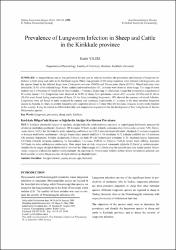| dc.contributor.author | Yıldız, Kader | |
| dc.date.accessioned | 2020-06-25T14:41:52Z | |
| dc.date.available | 2020-06-25T14:41:52Z | |
| dc.date.issued | 2006 | |
| dc.identifier.citation | Yıldız, K. (2006). Prevalence of lungworm infection in sheep and cattle in the Kırıkkale province. Türkiye Parazitoloji Dergisi, 30(3), 190 - 193. | en_US |
| dc.identifier.issn | 1300-6320 | |
| dc.identifier.issn | 2146-3077 | |
| dc.identifier.uri | https://app.trdizin.gov.tr/publication/paper/detail/TnpNM09EQXc= | |
| dc.identifier.uri | https://hdl.handle.net/20.500.12587/990 | |
| dc.description.abstract | Kırıkkale yöresindeki koyun ve sığırlarda akciğer kılkurdu enfeksiyonunun yayılışını ve yoğunluğunu belirlemek amacıyla bir yıl süreyle mezbahaya gidilmiştir. Incelenen 100 koyunun 34'ünde akciğer kılkurdu saptanmış olup; Cystocaulus ocreatus %50, Dictyocaulus filaria %23,5, her iki türün bir arada bulunduğu enfeksiyon ise %26,5 oranında tespit edilmiştir. Akciğerde C.ocreatus'un parazit ve kuluçka nodüllerine rastlanmıştır. Akciğer başına düşen parazit nodülleri 1-116 (ortalama 19,7), kuluçka nodülleri ise 1-5 (ortalama 2,8) arasında değişmiştir. Enfekte akciğerlerde D.filaria en fazla 45 adet bulunmuştur (ortalama 11,5). İncelenen koyun dışkılarının %14'ünde kılkurdu larvasına rastlanmış, bu hayvanlarda C.ocreatus (%52,4) ve D.filaria (%28,6) larvası tespit edilmiş, dışkıların %19'unda ise miks enfeksiyona rastlanmıştır. Hem otopsi hem de dışkı muayenesi sonucunda sığırlarda D.filaria'ya rastlanmamıştır. Anadolu'da en yaygın akciğer kılkurdu türü C.ocreatus'tur. Diğer yaygın tür D.filaria olup, bu parazitle aynı cins içinde yeralan Dictyocaulus viviparus'a ülkemizde nadiren rastlanmaktadır. Bu durumun iki Dictyocaulus türünün serbest dönem larvalarının gelişmek için farklı sıcaklık ve neme ihtiyaç duyması ile ilgili olabileceği düşünülmüştür. | en_US |
| dc.description.abstract | A slaughterhouse survey was performed for one year in order to determine the prevalence and intensity of lungworm infections in both sheep and cattle in the Kirikkale region. Thirty-four percent of 100 sheep examined were infected with lungworms and the species found in the infected lungs were Cystocaulus ocreatus (50.0%) and Dictyocaulus filaria (23.5%). Mixed infections were detected in 26.5% of the infected lungs. Worm nodules and brood nodules of C. ocreatus were observed in the lungs. The range of worm nodules was 1-116 (mean 19.7) and that of brood nodules, 1-5 (mean 2.8) per lung. D. filaria had a range that increased to a maximum of 45 worms (mean 11.5). Lungworms were observed in 14.0% of sheep fecal specimens. Larvae of C. ocreatus (52.4%) and D. filaria (28.6%) were found during examination of feces. Of the feces containing lungworms, 19% showed the presence of mixed infection. Lungworms were not found in cattle examined by autopsy and coprologic examination. C. ocreatus is the most prevalent lungworm species in Anatolia. D. filaria is another frequently seen lungworm species in Turkey while Dictyocaulus viviparus is very rarely reported in this country. It may be related to different humidity and temperature requirements for the development of free living larvae of the two Dictyocaulus species. | en_US |
| dc.language.iso | tur | en_US |
| dc.rights | info:eu-repo/semantics/openAccess | en_US |
| dc.subject | Parazitoloji | en_US |
| dc.subject | Genel ve Dahili Tıp | en_US |
| dc.title | Prevalence of lungworm infection in sheep and cattle in the Kırıkkale province | en_US |
| dc.title.alternative | Kırıkkale Bölgesi'nde koyun ve sığırlarda akciğer kurtlarının prevalansı | en_US |
| dc.type | article | en_US |
| dc.contributor.department | Kırıkkale Üniversitesi | en_US |
| dc.identifier.volume | 30 | en_US |
| dc.identifier.issue | 3 | en_US |
| dc.identifier.startpage | 190 | en_US |
| dc.identifier.endpage | 193 | en_US |
| dc.relation.journal | Türkiye Parazitoloji Dergisi | en_US |
| dc.relation.publicationcategory | Makale - Ulusal Hakemli Dergi - Kurum Öğretim Elemanı | en_US |
















